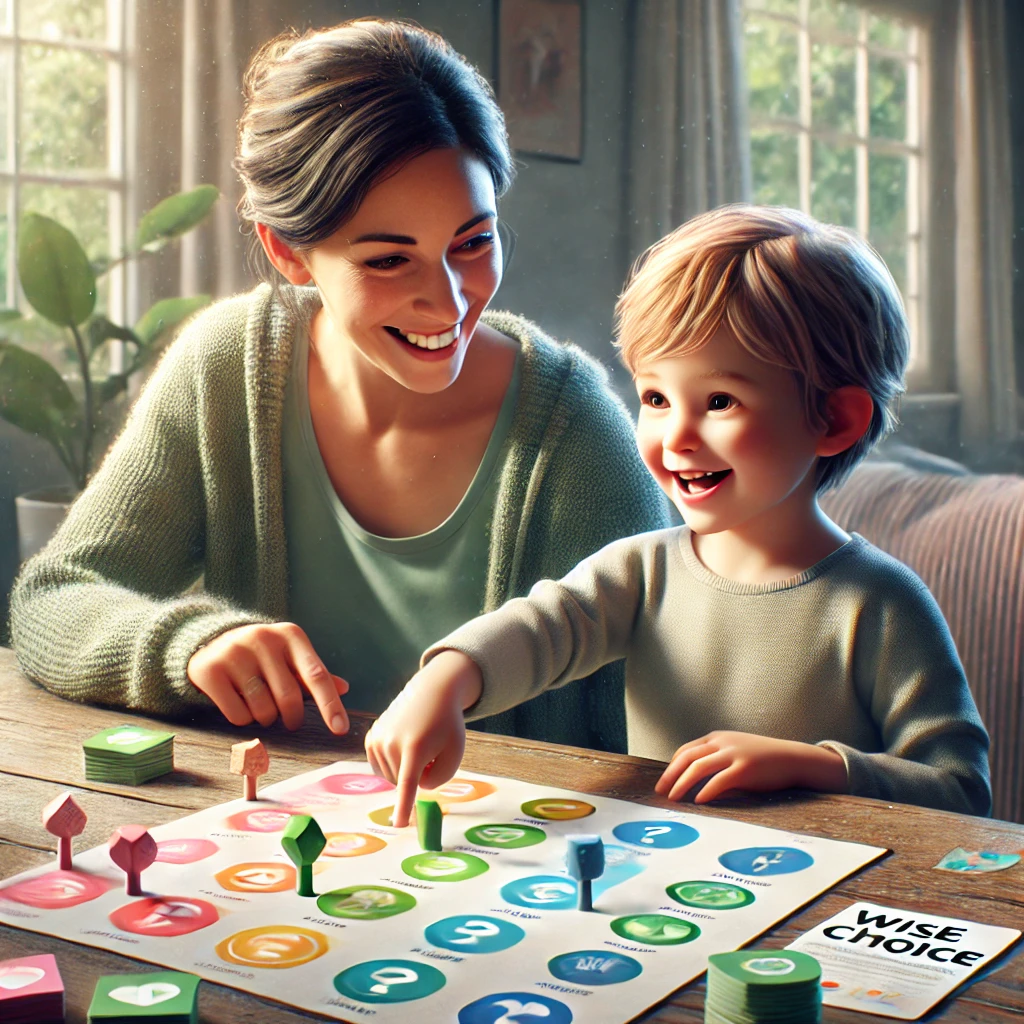Picture this: your child confidently deciding how to spend their allowance, calmly resolving a disagreement with a friend, or tackling a challenging homework assignment without hesitation. Decision-making might seem like an ordinary skill, but it’s the foundation for success in every area of life.
As parents, we all want to equip our children with the tools they need to survive and thrive in today’s world. Helping them learn to make wiser decisions is one of the greatest gifts we can give. And here’s the exciting part: modern science shows us that decision-making is a skill that can be taught—a skill that shapes confidence, strengthens relationships, and builds a brighter future.
If this sounds like something you want for your child, this article is for you.
Why Decision-Making is a Superpower 💪

In School:
Smart decision-making helps children prioritise tasks 📝, manage their time effectively ⏳, and learn valuable lessons from their mistakes 💡, paving the way for stronger academic performance.
In Relationships:
Decision-making empowers kids to navigate social situations with empathy and confidence. 🤝
Example: Instead of reacting impulsively during a disagreement, your child might calmly say, “Let’s figure out a solution together.”
In Life Readiness:
The ability to make thoughtful decisions prepares children to take responsibility ⚖️, face challenges 💪, and build resilience. These skills set them up for success in the real world.
The Science Behind Making Wiser Decisions 🧠✨
Understanding how your child’s brain processes choices and learns from experience is key to teaching decision-making effectively. Here’s what modern neuroscience and psychology reveal about nurturing this critical skill:

1.Predictive Processing: How the Brain Learns Through Feedback 🔄
The brain acts as a prediction machine, constantly guessing outcomes and adjusting based on feedback.
Why It Matters:
When your child practices decision-making, their brain fine-tunes its ability to predict outcomes, building confidence and improving accuracy over time.
Example:
Ask your child, “What do you think will happen if…?” This encourages them to think critically and connect their choices with potential consequences.
2.Growth Mindset: Embracing Effort and Learning from Mistakes 🌱
Dr. Carol Dweck’s Growth Mindset research shows that valuing effort over perfection helps children reframe mistakes as opportunities for growth.
Why It Matters:
When kids believe they can improve through practice, they’re more likely to take risks, embrace challenges, and learn from setbacks.
Example:
Instead of saying, “That wasn’t the best choice,” say, “I love how you thought about it! What might you do differently next time?” This reinforces the idea that learning happens through trying.

3.Lev Vygotsky’s Zone of Proximal Development (ZPD): Stretching, Not Stressing 🚀
Lev Vygotsky’s ZPD theory explains that children grow best when challenges are slightly beyond their current abilities but still achievable with guidance.
Why It Matters:
Gradual, supported decision-making builds confidence without overwhelming your child.
Example:
Start with low-stakes choices like picking a snack 🍎 or activity 🎨. Over time, move to more complex decisions like managing an allowance 💰 or resolving conflicts.
4. Solomon Effect: Gaining Clarity by Giving Advice 💬

The Solomon Effect highlights that people often make better decisions when imagining they’re advising someone else rather than solving their own problem.
Why It Matters:
When children adopt the role of a “wise friend,” they detach from their emotions and think more clearly.
Example:
If your child is struggling with a choice, ask, “What would you tell your best friend to do in this situation?” This perspective helps them make calmer, more thoughtful decisions.
By combining these principles—predicting outcomes, embracing effort, tackling manageable challenges, and thinking objectively—you’ll help your child develop the tools to make confident, thoughtful decisions that will serve them for a lifetime. 🌟
Now That We’ve Explored the Impact of Decision-Making 🌟
Let’s dive into a practical activity that transforms decision-making into a fun and engaging experience for your child. By practicing these steps regularly, you’ll help your child build the confidence, resilience, and critical thinking skills they need to thrive.
Introducing The Wise Choice Game—a simple yet powerful way to teach your child how to approach decisions thoughtfully and grow into a confident decision-maker. 🎮✨
The Wise Choice Game: Step-by-Step Guide 🛠️

Step 1: Create a Scenario 🎭
Start with a simple, relatable decision appropriate for your child’s age.
- Why it works: Helps children focus without feeling overwhelmed and sets the stage for complex decision-making later.
- Example Scenarios:
- “You have £5 to spend at the shop. What will you choose?”
- “Should we go to the park or play a board game today?”
- Pro Tip: Use everyday choices that your child can relate to for better engagement.
Step 2: Brainstorm Options 🤔

Ask your child to list possible choices and predict the outcomes of each.
- Why it works: Builds critical thinking by exploring cause-and-effect relationships.
- Example Questions:
- “What happens if you buy sweets now? What if you save your money for later?”
- “What might happen if you go to the park instead of playing the board game?”
- Pro Tip: Encourage creativity and curiosity—it’s about exploring possibilities, not just finding the “right” answer.
Step 3: Make the Decision ✅

Encourage your child to pick an option and explain their reasoning.
- Why it works: Builds confidence in their ability to trust their judgment.
- Example:
- “I’ll save my money because I want a bigger toy later.”
- “I’ll choose the park because I love playing on the swings!”
- Pro Tip: Praise their thought process. Say, “I love how you considered both options before deciding!”
Step 4: Reflect on the Outcome 🔍

After they’ve made their decision, discuss what happened and what they learned.
- Why it works: Reflection connects actions to outcomes, reinforcing the value of thoughtful decision-making.
- Example Questions:
- “How did it feel to save your money? Was it hard to wait for the bigger toy?”
- “What did you enjoy most about going to the park?”
- Pro Tip: Keep the conversation positive, even if the outcome wasn’t ideal. Celebrate the effort and discuss what they might do differently next time.
Step 5: Gradually Raise the Stakes 🚀

As your child becomes more confident, introduce higher-stakes or more complex decisions.
- Why it works: Gradual challenges encourage advanced decision-making skills without overwhelming them.
- Example:
- “Plan a family weekend activity that everyone will enjoy.”
- “How should you budget your allowance to save for something special?”
- Pro Tip: Allow room for mistakes—they’re a valuable part of the learning process.
Why It Matters
The Wise Choice Game equips your child with lifelong skills:
- Confidence: Trusting their own judgment.
- Resilience: Learning from mistakes and bouncing back.
- Critical Thinking: Evaluating options and predicting outcomes.
Every decision becomes a chance for growth. And as a parent, you’ll notice the ripple effects: less stress, stronger relationships, and a more independent, thoughtful child. 🌟
So grab a scenario, brainstorm some options, and let the Wise Choice Game transform decision-making into an adventure! 🌈✨
Dos and Don’ts for Teaching Decision-Making ✅❌

✅ Do: Celebrate effort, not just results. 🎉
- Praising the process teaches your child to value learning and persistence over achieving a perfect outcome.
- Example: “I’m proud of how you thought about your options!”
❌ Don’t: Focus too much on perfection. ❌
- Emphasising perfection can make your child afraid to make mistakes, which hinders growth.
- Example: Avoid saying, “Why didn’t you choose the better option?”
✅ Do: Keep the practice engaging and fun. 🕹️
- Incorporating games or playful activities makes learning enjoyable and increases participation.
- Example: “Let’s turn this decision into a fun game!”
❌ Don’t: Push your child into decisions they’re not ready for. 🚫
- Forcing a decision too soon can overwhelm them and damage confidence.
- Example: Avoid saying, “You should know what to do by now.”
✅ Do: Adapt the activity to your child’s pace and interests. 🎯
- Tailoring the challenge to your child’s comfort zone ensures they stay motivated and build confidence.
- Example: “Would you rather decide on a snack or a game for today?”
❌ Don’t: Compare their progress to others. 🌈
- Every child’s journey is unique, and comparisons can discourage them.
- Example: Avoid saying, “Your friend does this so much faster.”
Final Thoughts: Decision-Making as a Lifelong Gift 🌟

Teaching your child the art of thoughtful decision-making is truly a lifelong gift. 🎁 With each small decision, they’re learning to trust themselves, embrace challenges, and grow into a resilient, confident individual ready to navigate the complexities of life.
Celebrate every effort, no matter how small, and remember—it’s not about perfection but progress. Trust the process, and enjoy watching your child thrive one thoughtful choice at a time. 🌈✨
Found this guide useful? Help others discover the Getting to Give Project by sharing it. Your support allows more parents to access cutting-edge, science-backed resources at no cost. 🌟 Thank you for reading!
🎒 Adapting the Game for Different Ages
For Younger Kids (Ages 4-7)
Use simple, everyday decisions like choosing between two activities or solving small disagreements. For instance, “What would you tell your friend to do if they had to pick between two toys?”
For Elementary Age (Ages 8-12)
Try slightly more complex scenarios, such as, “What would you tell a friend who feels left out?” or “How would you help a friend decide whether to tell the truth about something?”
For Teens (Ages 13+)
Practice with more nuanced situations like, “What advice would you give a friend facing peer pressure?” or “How would you guide a friend deciding on a big responsibility?”
📚 Further Reading on the Science of Decision-Making
The Solomon Effect
The Solomon Effect, also known as Solomon’s Paradox, refers to the phenomenon where individuals reason more wisely about others’ problems than their own.
- The (Paradoxical) Wisdom of Solomon
This article explores how people often reason more wisely about others’ dilemmas than their own, highlighting the psychological mechanisms behind this effect.(psychologicalscience.org)
- Be Aware of Solomon’s Paradox, and Make Better Decisions
This piece discusses strategies to overcome Solomon’s Paradox, enabling individuals to apply objective reasoning to their personal decisions. (turningmanagersintoleaders.com)
Predictive Processing Theory
Predictive Processing Theory posits that the brain continuously generates and updates a model of the environment to predict sensory input. This framework is crucial for understanding adaptability and decision-making.
- An Introduction to Predictive Processing Models of Perception and Decision-Making
This article provides a comprehensive overview of how predictive models are utilized in perception and decision-making processes. (onlinelibrary.wiley.com)
- Your Mind Needs Chaos
This interview discusses how embracing uncertainty and engaging in creative activities can enhance the brain’s predictive models, fostering adaptability. (vox.com)
Lev Vygotsky’s Zone of Proximal Development (ZPD)
Vygotsky’s ZPD describes the difference between what a learner can do without help and what they can achieve with guidance, emphasizing the importance of social interaction in learning.
- Vygotsky’s Zone of Proximal Development
This article explains the concept of ZPD and its significance in educational settings, highlighting how supported challenges facilitate learning. (simplypsychology.org)
- Vygotsky’s Theory of Cognitive Development
This resource delves into Vygotsky’s broader theories, including the ZPD, and discusses their implications for teaching and learning. (simplypsychology.org)




















